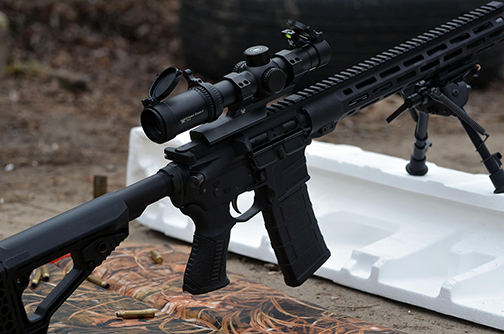A Guide to AR-15 Calibers
Ask any gun owner, “What caliber is the AR-15 rifle?” most will respond 5.56, after 5.56x45mm NATO, its original chambering. The “five-five-six” is the caliber of the original military M16 rifle and its civilian equivalent, the Colt AR-15 SP1 sporter rifle (Model R6000), released in 1964.
But did you know that the original SP1 receiver was marked “CAL .223” for .223 Remington? In the 1960s, 5.56x45mm ammunition was not readily available to civilian gun owners, but the .223 Remington cartridge it is based on was.
Initially, the AR-15 could always shoot multiple calibers, starting with 5.56mm and .223. In the 60 years that followed, the platform was modernized many times and adapted to different calibers.
This guide will break down some of the best calibers for the AR-15 and how each one affects the performance of your favorite rifle.
5.56x45mm NATO / .223 Remington
The 5.56x45mm NATO is the original chambering for the AR-15 platform, including the military M16 rifles, M4 carbines, and most civilian ARs.
If you’ve ever asked yourself, “What caliber is the AR-15 rifle?” the technically correct answer is 5.56x45mm. However, virtually every AR-15 can also safely shoot .223 Remington ammunition.
Although 5.56 and .223 are different caliber designations, they have identical external dimensions and feature 0.224-inch diameter bullets of identical weights (55-grain, 62-grain, etc.). The main difference between the two is the maximum amount of pressure each cartridge is designed to generate.
- .223 Remington: 55,000 psi
- 5.56x45mm NATO: 62,366 psi
Assuming both cartridges are fitted with bullets of the same weight, 5.56x45mm NATO makes more pressure on average. As the AR-15 is designed for 5.56x45mm NATO, shooting .223 Remington will produce less velocity and power and less wear and tear. So, the real answer to “What caliber is the AR-15 rifle?” is both 5.56x45mm and .223 Remington.
Common Applications and Bullets for 5.56mm and .223
The AR-15’s original 5.56x45mm chambering was designed for combat and military applications. Early military ammunition used 55-grain bullets, whereas modern ones use 62-grain projectiles. For civilians, both are suitable for training, shooting practice, and self-defense.
Other civilian-specific ammunition is also widely available for more specialized purposes. Typical examples include soft points for varmint hunting or open-tip match (OTM) for long-range precision shooting.
| Typical bullet | Typical muzzle velocity | Typical muzzle energy | Common applications |
|---|---|---|---|
| 55-grain FMJ | 3,200 to 3,300 ft/s | 1,250 to 1,330 ft-lbf |
|
|
62-grain
FMJ green-tip |
3,000 to 3,200 ft/s | 1,239 to 1,409 ft-lbf |
|
|
70-grain
Soft point |
2,800 to 2,900 ft/s | 1,218 to 1,307 ft-lbf |
|
|
77-grain
OTM |
2,650 to 2,850 ft/s | 1,200 to 1,389 ft-lbf |
|
Reasons for Choosing a 5.56mm AR-15
There are many reasons to consider sticking to your AR’s original chambering and not using any other caliber. Here’s a breakdown of the 5.56mm AR-15’s benefits and unique characteristics:
- Versatility. AR-15s chambered in 5.56mm can safely shoot the full spectrum of civilian and military-specification ammunition in both .223 and 5.56. Shooters can access a wide variety of projectiles and weights best suited for plinking, training, self-defense, hunting, sport shooting, and more.
While not every 5.56 barrel can fire every bullet accurately, most can produce acceptable performance when paired with typical ammunition available. - Most extensive third-party support. AR-15 parts and accessories are generally plentiful across all calibers. However, most third-party components are designed around the original military-specification parts in 5.56/.223.
This is especially true if you need magazines. While numerous third-party magazine manufacturers exist, virtually all produce 5.56 versions in various capacities ranging from 10 to over 100. - Cost-effectiveness. Of all the caliber options for the AR-15, 5.56/.223 ammunition is generally the most plentiful and economical. It is also the easiest caliber to buy in bulk; numerous ammo manufacturers readily sell 500 or 1,000 rounds packages.
- Naturally accurate. Whether you prefer shooting from a rifle or a carbine, the cartridge’s natural performance is the biggest advantage of choosing 5.56/.223. Both generally produce high velocities, a flat trajectory, and acceptable accuracy for most applications. Most gun owners can train to shoot 5.56 accurately at 300 yards, and Marine riflemen can reliably hit targets with the same ammunition at up to 500.

.300 Blackout
The .300 AAC Blackout, also called .300 Blackout or .300 BLK, is a popular alternative AR-15 cartridge designed by Advanced Armament Corporation (AAC). It was introduced in 2010 as an alternative chambering for the military M4 carbine before hitting the civilian market.
Before the cartridge’s introduction, special forces operators of the time needed a cartridge capable of delivering adequate performance in guns equipped with suppressors.
While it is possible to suppress 5.56x45mm ammunition, supersonic bullets still produce a loud, audible crack, whereas subsonic projectiles do not deliver enough energy to be considered effective. Because of this limitation, most operators relied on pistol-caliber platforms instead, such as suppressed MP5 9mm submachine guns, despite their limited range.
.300 BLK was created to answer these needs, offering .30-caliber power in an AR-15 without compromising the performance and reliability of the 5.56 cartridge.
There are two categories of .300 BLK ammunition: supersonic and subsonic loads. The former delivers performance comparable to the 7.62x39mm from an AK-47, whereas the latter can be effectively suppressed while offering several times the power of a subsonic 5.56.
Common Applications for .300 Blackout AR-15s
When .300 Blackout was introduced to the civilian market, gun owners could access many of the same projectiles as military and special forces. Bullet weights range from 110 to 220 grains; lighter bullets (110 to 150-grain) are usually supersonic, whereas heavier ones (180-gr) are subsonic.
| Typical bullet | Typical muzzle velocity | Typical muzzle energy | Common applications |
|---|---|---|---|
| 150-grain FMJ | 1,900 to 2,000 ft/s | 1,202 to 1,332 ft-lbf |
|
|
110-grain
JHP with ballistic tip |
2,300 to 2,500 ft/s | 1,292 to 1,526 ft-lbf |
|
|
220-grain
TMC subsonic |
1,050 to 1,100 ft/s | 539 to 591 ft-lbf |
|
Reasons for Choosing a .300 Blackout AR-15
Although .300 Blackout is no longer a new cartridge on the market, it still offers many unique advantages and characteristics worth considering.
- Easy conversion. Converting a 5.56mm AR-15 to .300 Blackout is theoretically simple; the only new part needed is a barrel. The ammunition is compatible with standard AR-15 bolts, magazines, and many other parts.
For more convenience, you can purchase or assemble an upper receiver with a .300 Blackout barrel, allowing you to swap between calibers in seconds. - Same magazines and capacity. Many alternative calibers for AR-15 platforms require either proprietary magazines or fit in standard ones with a loss of capacity. With .300 Blackout, you get neither disadvantage. A 30-round 5.56 magazine will hold 30 rounds of .300 BLK without issues.
- Excellent for special applications. Subsonic .300 Blackout ammunition is favored by special forces operators worldwide for its performance in short-barreled and suppressed firearms. You can get the most out of this cartridge’s capabilities with a .300 BLK AR pistol, a legal short-barreled rifle (SBR), or a .30-caliber suppressor.

6mm ARC
Hornady Ammunition introduced the 6mm Advanced Rifle Cartridge (ARC) in 2020. This alternative AR-15 caliber can be considered a more advanced version of the 6.5mm Grendel introduced in the early 2000s.
Hornady initially designed the cartridge to respond to the needs of an unnamed Department of Defense entity. It is designed to generate a very high ballistic coefficient (BC), meaning these bullets are highly accurate at long ranges. In essence, the 6mm ARC cartridge transforms the AR-15 platform into a long-distance precision rifle comparable to modern military sniper rifles.
Common Applications for 6mm ARC AR-15
Instead of its predecessor’s 0.264-inch projectiles, the 6mm ARC uses 0.243-inch diameter projectiles. Hornady introduced three closely performing loads with 103-, 105-, and 108-grain bullets to demonstrate the cartridge’s performance. Today, a broader range of 6mm ARC projectiles is available, ranging from 75 to 108 grains.
| Typical bullet | Typical muzzle velocity | Typical muzzle energy | Common applications |
|---|---|---|---|
|
75-grain
JHP with ballistic tip |
2,800 to 2,900 ft/s | 1,305 to 1,400 ft-lbf |
|
|
105-grain
BTHP |
2,700 to 2,800 ft/s | 1,699 to 1,828 ft-lbf |
|
|
108-grain
Match |
2,700 to 2,800 ft/s | 1,748 to 1,880 ft-lbf |
|
Reasons for Choosing a 6mm ARC AR-15
Although the 6mm ARC is one of the newest AR-15 cartridges on the market today, it has gained acceptance from many shooters for its exceptional performance. Here are the main reasons to consider 6mm ARC:
- Long-distance performance. If you enjoy the AR platform for the accuracy and flat trajectory of the 5.56 cartridge, think of the 6mm ARC as a high-performance equivalent. AR rifles chambered in this platform are commonly paired with quality optics for competition and long-distance precision shooting. The best projectiles are accurate at up to 1,000 yards and extremely flat-shooting, with less than 50 inches of drop from the muzzle at 500 yards.
- Availability of specialized parts. Converting an AR-15 to 6mm ARC requires more work and parts than .300 BLK; you’ll need a new barrel, bolt, and bespoke magazines. However, the bolts and magazines are interchangeable with 6.5mm Grendel, which has been on the market for over 20 years. This makes many of these parts commonly available and reasonably priced.
- High hunting performance. The 6mm ARC is a highly precise cartridge that produces tight groups at typical hunting distances, making it an excellent choice for hunting. Many high-performance hunting projectiles are available and are suited for varmint and medium-sized game. Using this cartridge, skilled hunters have successfully brought down animals such as black bears or cougars at up to 600 yards.
Other Calibers To Consider
The AR-15 platform has been adapted and modified many times throughout its life. While the examples above are some of the best performers in their respective categories, gun owners have many more choices. Here are some of them and why you should consider them.
- .350 Legend. This straight-walled cartridge accepts heavy .35-caliber bullets and is primarily designed for deer hunting. Its ballistic performance is comparable to the classic .30-30 Winchester, making it a great choice to turn your AR into a deer hunting rifle. The straight-walled construction also makes it legal to use in jurisdictions with bans on bottlenecked cartridges.
- .450 Bushmaster. A heavy-hitting straight-walled cartridge designed to accept large, 250 to 300-grain .45-caliber projectiles. With a typical muzzle velocity of 2,200 ft/s, the .450 Bushmaster is a high-recoiling round with enough power to hunt elk, moose, or grizzly.
- 7.62x39mm. This well-known cartridge of Soviet origin is most commonly associated with the AK-47. Most AR-15s chambered in 7.62x39mm use proprietary bolts and magazines that are not interchangeable with those of the AK. However, 7.62x39mm is relatively inexpensive and has proven effectiveness for hunting and self-defense, making it an unusual but effective choice for the budget-conscious.
Find AR-15s, Parts, and Ammunition at IFA Tactical
So, what caliber is the AR-15 rifle today? The answer depends on the specific make and model. While 5.56/.223 remains king, numerous AR-platform firearms in alternative chamberings are available, with new calibers appearing frequently. Whether you prefer to stick to the classics or opt for a more specialized option, you are sure to find at least one AR-15 caliber.
IFA Tactical in Sterling Heights, MI, carries a wide selection of AR-pattern rifles from numerous manufacturers. Browse our selection and find the perfect AR-15 for self-defense, hunting, plinking, competition, or exercising your Second Amendment rights. Contact our team today for assistance.

